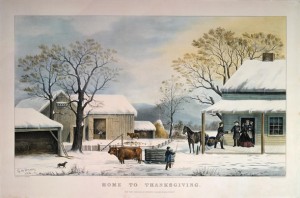Home » Early National U.S. (Page 3)
Category Archives: Early National U.S.
Celebrating the Holidays through History: Christmas
Over the River and Through the Wood: Defining Domesticity in Nineteenth-Century America
Over the river, and through the wood-
when Grandmother sees us come,
She will say, “O, dear, the children are here,
bring pie for everyone.”Over the river, and through the wood-
now Grandmothers cap I spy!
Hurrah for the fun! Is the pudding done?
Hurrah for the pumpkin pie!
 While the twelve verses in the original poem, connect with our collective ideal of the American past, the author of Over the River and Through the Wood was acutely aware of the injustices and inequalities inherent in American society. Lydia Maria Child is best remembered as “a tireless crusader for truth and justice and a champion of excluded groups in American society—especially Indians, slaves, and women” and this focused determined the course of her literary career. Originally titled The New England Boy’s Song about Thanksgiving Day and published in a collection of poetry for children, the poem is representative of Child’s writing for children. This writing focused on a range of subjects, from history and literature, to slavery, Native Americans, and other reform causes, to botany and other sciences. Most importantly, the poems and short stories focused on American issues and the inculcation of American values. The success of Over the River and Through the Wood at this task of inculcating American values is readily apparent in its continued relevance to the celebration of winter holidays. Read more.
While the twelve verses in the original poem, connect with our collective ideal of the American past, the author of Over the River and Through the Wood was acutely aware of the injustices and inequalities inherent in American society. Lydia Maria Child is best remembered as “a tireless crusader for truth and justice and a champion of excluded groups in American society—especially Indians, slaves, and women” and this focused determined the course of her literary career. Originally titled The New England Boy’s Song about Thanksgiving Day and published in a collection of poetry for children, the poem is representative of Child’s writing for children. This writing focused on a range of subjects, from history and literature, to slavery, Native Americans, and other reform causes, to botany and other sciences. Most importantly, the poems and short stories focused on American issues and the inculcation of American values. The success of Over the River and Through the Wood at this task of inculcating American values is readily apparent in its continued relevance to the celebration of winter holidays. Read more.
“Now Bring Us Some Figgy Pudding”: Plum Pudding and the Celebration of Christmas in Nineteenth-Century America
Hallo! A great deal of steam! The pudding was out of the copper. A smell like a washing-day! That was the cloth. A smell like an eating-house and a pastrycook’s next door to each other, with a laundress’s next door to that! That was the pudding! In half a minute Mrs. Cratchit entered—flushed, but smiling proudly—with the pudding, like a speckled cannon-ball, so hard and firm, blazing in half of half-a-quartern of ignited brandy, and bedight with Christmas holly stuck into the top.
A major source was English holiday tradition, leading many American cooks to embrace plum pudding for the finale to their Christmas dinner and Christmas trees in their parlors (this custom was popularized by Queen Victoria after her marriage to Albert. He brought the tradition from Germany). A rich dried fruit, suet pudding that is well laced with brandy, plum pudding has been firmly associated with English Christmas celebrations for several centuries. Despite the name, most plum puddings contain far more raisins than plums. The fact that figgy pudding and plum pudding are one and the same suggests how little relevance the ingredients have to the name. Recipes usually included a combination of several dried fruits, most commonly raisins, plums, and currants. Liquor was the liquid of choice for most plum pudding recipes ranging from Madeira, whiskey, and a wide variety of homemade wines. The popularity of the Temperance movement would lead the development of Temperance recipes later in the century. Read more.


